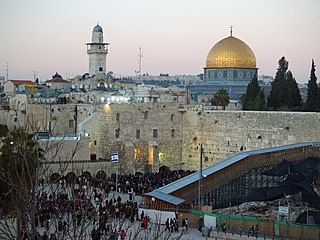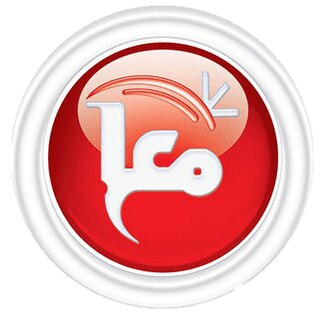
The Gaza Strip, or simply Gaza, is a small, densely populated territory located on the eastern coast of the Mediterranean Sea. It is the smaller of the two Palestinian territories. Gaza is bordered by Egypt on the southwest and Israel on the east and north.

Palestinian Christians are a religious community of the Palestinian people consisting of those who identify as Christians, including those who are cultural Christians in addition to those who actively adhere to Christianity. They are a religious minority within the State of Palestine and within Israel, as well as within the Palestinian diaspora. Applying the broader definition, which groups together individuals with full or partial Palestinian Christian ancestry, the term was applied to an estimated 500,000 people globally in the year 2000. As most Palestinians are Arabs, the overwhelming majority of Palestinian Christians also identify as Arab Christians.

The Palestinian Authority, officially known as the Palestinian National Authority or the State of Palestine, is the Fatah-controlled government body that exercises partial civil control over the Palestinian enclaves in the Israeli-occupied West Bank as a consequence of the 1993–1995 Oslo Accords. The Palestinian Authority controlled the Gaza Strip prior to the Palestinian elections of 2006 and the subsequent Gaza conflict between the Fatah and Hamas parties, when it lost control to Hamas; the PA continues to claim the Gaza Strip, although Hamas exercises de facto control. Since January 2013, the Palestinian Authority has used the name "State of Palestine" on official documents, although the United Nations continues to recognize the Palestinian Liberation Organization (PLO) as the "representative of the Palestinian people".

The Israeli–Palestinian conflict is an ongoing military and political conflict about land and self-determination within the territory of the former Mandatory Palestine. Key aspects of the conflict include the Israeli occupation of the West Bank and Gaza Strip, the status of Jerusalem, Israeli settlements, borders, security, water rights, the permit regime, Palestinian freedom of movement, and the Palestinian right of return.

Gaza, also called as Gaza City, is a city in the Gaza Strip, Palestine. As of 2022, it is the largest city in the State of Palestine, with 590,481 inhabitants in 2017. The city is spread across an area of 45 square kilometres (17 sq mi). Gaza is one of the principal coastal cities in the country, home to Palestine's only port. Located some 76.6 kilometres (47.6 mi) northwest from the country's proclaimed capital Jerusalem, the city is located on the coast of the Mediterranean Sea. Prior to the 2023 Israel–Hamas war, it was the most populous city in the State of Palestine, when massive displacement happened during the war.

The Palestinian territories, also known as the Occupied Palestinian Territory, consist of the West Bank and the Gaza Strip—two regions of the former British Mandate for Palestine that have been occupied by Israel since the Six-Day War of 1967.

Palestine, officially the State of Palestine, is a country in the southern Levant region of West Asia, encompassing the Israeli-occupied West Bank and Gaza Strip, within the larger historic Palestine region. The country shares most of its borders with Israel, and borders Jordan to the east and Egypt to the southwest. It has a combined land area of 6,020 square kilometres (2,320 sq mi) while its population exceeds five million people. Its proclaimed capital is Jerusalem while Ramallah serves as its administrative center and Gaza City was its largest city until 2023.

The economy of the State of Palestine refers to the economic activity of the State of Palestine. Palestine receives substantial financial aid from international donors, including governments and international organizations. In 2020, the inflation rate of -0.7% and unemployment rate was 25.9%. While exports were recorded at US$ 1 billion, with an import value of US$ 6 billion. Contributors to the national economy is service sector (47%), wholesale and repair (19%), manufacturing (12%), agriculture (7%), finance and banking (3%), construction (5%), information technology (5%) and transportation sector (2%).

This article describes transport in the State of Palestine, which consists of two non-contiguous territories, the West Bank and the Gaza Strip, different parts of which are administered by Palestinian National Authority, Hamas Administration in Gaza and Israel.

Tourism in Israel is a major economic sector and a significant source of national income. Israel offers a plethora of historical and religious sites, beach resorts, natural sites, archaeological tourism, heritage tourism, adventure tourism, and ecotourism. For practical reasons, this article also covers tourism in the West Bank and the Golan Heights, since it is closely interconnected with the mass tourism in Israel. In 2019, Israel saw a record 4.55 million tourist arrivals, with tourism contributing NIS 20 billion to the national economy in 2017.

The state of human rights in the West Bank and Gaza Strip is determined by Palestinian as well as Israeli policies, which affect Palestinians in the occupied Palestinian territories both directly and indirectly, through their influence over the Palestinian Authority (PA). Based on The Economist Democracy Index this state is classified as an authoritarian regime.
Freedom of religion is the freedom to practice religion, change one's religion, mix religions, or to be irreligious. Religion in the State of Palestine plays a strong role in society, including in the legal system and the educational system.

A blockade has been imposed on the movement of goods and people in and out of the Gaza Strip since Hamas's takeover in 2007, led by Israel and supported by Egypt. The blockade's current stated aim is to prevent the smuggling of weapons into Gaza; previously stated motivations have included exerting economic pressure on Hamas. Human rights groups have called the blockade illegal and a form of collective punishment, as it restricts the flow of essential goods, contributes to economic hardship, and limits Gazans' freedom of movement. The blockade and its effects have led to the territory being called an "open-air prison".

Ma'an News Agency is a large wire service created in 2005 in the Palestinian territories. It is part of the Ma'an Network, a non-governmental organization media network created in 2002 in the Palestinian territories among independent journalists throughout the West Bank and Gaza Strip. It has partnerships with eight local television stations and twelve local radio stations. Ma'an News Agency publishes news 24 hours a day in Arabic, Hebrew and English, and claims to be one of the largest wire services in the Palestinian territories, with over three million visits per month. Ma'an News Agency also publishes feature stories, analysis and opinion articles. The agency's headquarters are based in Bethlehem and it has an office in Gaza.

The economy of the Gaza Strip was dependent on small industries and agriculture. After years of decline, the Gaza economy experienced some growth in the late 2000s, boosted by foreign aid. According to the International Monetary Fund, the economy grew 20 percent in 2011, and the per capita gross domestic product increased by 19 percent.
Events in the year 2010 in the Palestinian territories.
Events in the year 2008 in the Palestinian territories.

Hamas has governed the Gaza Strip in Palestine since its takeover of the region from rival party Fatah in June 2007. Hamas' government was led by Ismail Haniyeh from 2007 until February 2017, when Haniyeh was replaced as leader of Hamas in the Gaza Strip by Yahya Sinwar. As of November 2023, Yahya Sinwar continues to be the leader of Hamas in the Gaza Strip. In January 2024, due to the ongoing Israel–Hamas war, Israel said that Hamas lost control of most of the northern part of the Gaza Strip. In May 2024, Hamas regrouped in the north.

Restrictions on the movement of Palestinians in the Israeli-occupied territories by Israel is an issue in the Israeli–Palestinian conflict. According to B'Tselem, following the 1967 war, the occupied territories were proclaimed closed military zones. In 1972, general exit orders were issued allowing residents of those territories to move freely between the West Bank, Israel and the Gaza Strip. Following the First Intifada by 1991, the general exit orders were revoked, and personal exit permits were required. According to B'Tselem, a measure of overall closure of the territories was enacted for the first time in 1993, and would result in total closures following rises in Palestinian political violence.

Palestine produces no oil or natural gas and is predominantly dependent on the Israel Electric Corporation (IEC) for electricity. According to UNCTAD, the Palestinian Territory "lies above sizeable reservoirs of oil and natural gas wealth" but "occupation continues to prevent Palestinians from developing their energy fields so as to exploit and benefit from such assets." In 2012, electricity available in West Bank and Gaza was 5,370 GW-hour, while the annual per capita consumption of electricity was 950 kWh. National sources only produce 445 GWh of electricity, supplying less than 10% of demand. The only domestic source of energy is the disputed Gaza Marine gas field, which has not yet been developed. Palestinian energy demand increased rapidly, increasing by 6.4% annually between 1999 and 2005. Future consumption of electricity is expected to reach 8,400 GWh by 2020 on the expectation that consumption will increase by 6% annually.




















